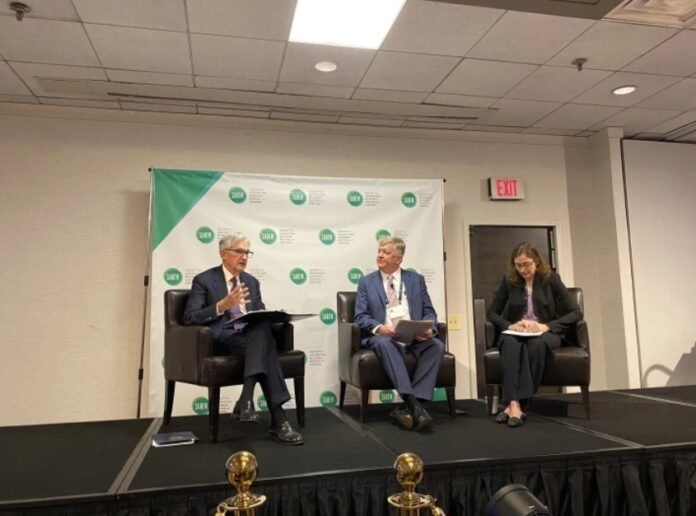As the Trump administration’s sweeping policy changes on tariffs, immigration, and government spending continue to unfold, their potential ramifications on the U.S. economy remain unclear. The effects of these changes are still being measured, leaving many to wonder how they will shape economic growth, inflation, and employment. In light of this uncertainty, Jerome Powell, the chairman of the Federal Reserve, has expressed a cautious stance regarding any immediate changes to the central bank’s approach on interest rates.
At a recent conference hosted by the Society for Advancing Business Editing and Writing, Powell emphasized that while the administration’s policies are sure to have significant consequences, it is still too early to determine how these developments will necessitate changes to monetary policy. “It’s just too soon to say what the appropriate monetary policy response to these new policies will be,” Powell stated. His message was clear: the Federal Reserve is adopting a “wait-and-see” approach, keen to monitor the effects of these policies over time before making any significant moves.
Uncertainty Looms as New Policies Take Shape
Under President Trump’s administration, major shifts in economic policy have been implemented or proposed, including the imposition of tariffs on international trade, changes to the immigration system, and shifts in government spending priorities. Each of these moves has stirred debate, with critics arguing that such policies could potentially lead to trade wars, economic stagnation, and increased costs for consumers. On the other hand, proponents believe these policies could boost domestic industries, encourage job growth, and strengthen U.S. interests globally.
Despite the varying perspectives, what remains certain is that these policies will undoubtedly impact the U.S. economy—how exactly, however, remains an open question. Tariffs, for instance, could disrupt global supply chains, raise costs on imported goods, and affect consumer prices. At the same time, changes to immigration could influence labor force dynamics, particularly in sectors reliant on foreign workers. Meanwhile, shifts in government spending priorities may either stimulate or restrain economic growth, depending on how they are structured and implemented.
Given these complexities, Powell noted that a key factor influencing the Fed’s approach is the level of uncertainty surrounding these changes. “Fast forward a year from now,” Powell suggested, “the uncertainty will be much lower and the effects of the policies will be clear.” It is in this context of ambiguity that the Fed is opting for a cautious approach, preferring to wait until the economic impacts are better understood before taking any drastic action.
The Fed’s Dual Mandate: Price Stability and Maximum Employment
While political and economic uncertainty swirls, the Federal Reserve remains focused on its long-standing dual mandate: to maintain price stability and ensure maximum employment. This responsibility, set out by Congress, is a central guiding principle for the Fed’s decisions on interest rates and broader monetary policy.
For Powell and his colleagues at the Fed, the main goal is to foster a stable and growing economy—one where inflation remains at manageable levels and unemployment is low. As the economy adjusts to the new administration’s policies, the Fed is closely monitoring key indicators like inflation trends, consumer spending, and labor market conditions.
In the past, the central bank has been quick to respond to inflationary pressures or shifts in employment levels. However, in this case, Powell’s remarks suggest that the Fed is waiting for the economic landscape to stabilize before making any policy changes that could have long-term consequences. The decision not to immediately adjust interest rates, for instance, reflects a desire to avoid overreacting to uncertainty. Instead, the Fed is taking a more measured approach, carefully evaluating how the administration’s policies will influence inflation and employment over time.
Tariffs and Trade Wars: Weighing the Impact
One of the most significant elements of President Trump’s economic policies has been his administration’s approach to tariffs, particularly the imposition of tariffs on goods imported from countries like China. While these tariffs were designed to pressure trading partners to comply with U.S. demands, they have also led to retaliatory measures, raising concerns about the onset of a trade war.
The impact of these tariffs on U.S. inflation is a primary concern for the Fed. If higher tariffs lead to rising consumer prices, it could prompt the Fed to consider raising interest rates to control inflation. However, if the tariffs result in slower economic growth and higher unemployment, the Fed may take the opposite approach by lowering rates or maintaining them at current levels to stimulate the economy.
Powell’s remarks suggest that the Fed is keeping a close eye on the evolving situation but refrains from taking action until the true effects of these tariffs are clearer. As he stated, the full impact of these policies is still “too soon to say,” but in time, the consequences will be more apparent, and the Fed will then adjust its strategy accordingly.
Immigration and Labor Force: Navigating Changing Demographics
Another significant policy shift under the Trump administration involves immigration, with tighter controls and restrictions placed on the flow of workers into the country. For sectors like agriculture, technology, and healthcare, immigration has long been a vital source of labor. If these restrictions remain in place, it could lead to labor shortages and disrupt industries that depend on foreign workers.
For the Fed, a shrinking labor force could create challenges in maintaining full employment, one of its core mandates. A reduction in the number of available workers could drive up wages, potentially contributing to inflationary pressures. On the other hand, if fewer immigrants are entering the U.S., it could limit the growth of the labor market, creating a drag on overall economic output.
As with the effects of tariffs, Powell indicated that the central bank is closely monitoring the potential ramifications of immigration changes, but he emphasized the need for patience in understanding how these policies will play out. While the Fed has tools at its disposal to address inflation or unemployment, Powell made it clear that any intervention would come only once the economic effects of the policies become more predictable.
Conclusion: The Fed’s Strategic Patience
As 2020 unfolds, the U.S. economy finds itself navigating a period of uncertainty, with significant changes in trade, immigration, and government spending policies. The Federal Reserve’s decision to adopt a cautious, wait-and-see approach is not an abdication of responsibility, but rather a reflection of the complex and unpredictable nature of these policy changes. By maintaining its focus on its dual mandate—price stability and maximum employment—the Fed is prioritizing measured, data-driven responses over quick, potentially hasty actions.
For now, it is clear that the Federal Reserve will continue to observe the effects of the Trump administration’s economic policies closely. As Powell suggested, the uncertainty surrounding these policies will diminish with time, allowing for a clearer understanding of their long-term impact on inflation, employment, and economic growth. Until then, the central bank’s strategy remains one of strategic patience, allowing the economy to adjust before determining the most appropriate course of action.




